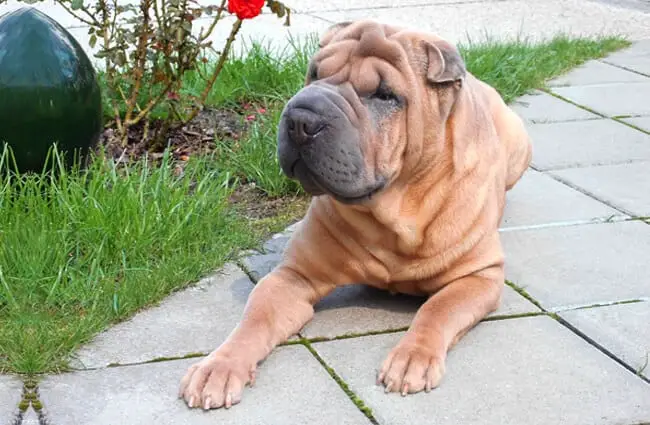The Chinese Shar‑pei, a breed shrouded in ancient history and possessing a uniquely dignified appearance, presents a captivating choice for the discerning dog owner. Often recognized by their deeply wrinkled skin and distinctive blue‑black tongue, these dogs are more than just a striking visual. This guide delves into the world of the Shar‑pei, exploring its origins, temperament, care requirements, and fascinating quirks.

A Journey Through Time: The History of the Chinese Shar‑pei
The Shar‑pei’s lineage stretches back over two millennia to ancient China. Originally bred in Guangdong province, its earliest purpose remains somewhat debated. Some historians believe they were all-purpose farm dogs used for herding, hunting, and guarding. Others suggest they served as fighting dogs prized for their courage and tenacity. The name “Shar‑pei” translates to “rough coat,” a descriptive nod to their uniquely textured fur.
During the mid-20th century, the breed faced near extinction due to political upheaval and societal changes in China. Thankfully, a small number of dogs were exported to the West, primarily to the United States, where dedicated breeders worked tirelessly to revive the breed. The American Kennel Club officially recognized the Shar‑pei in 1991.
Physical Characteristics: Size, Weight, and Appearance
The Shar‑pei is a medium‑sized dog, known for its robust build and distinctive wrinkles. Adult males typically stand between 19 and 21 inches tall and weigh between 50 and 60 pounds. Females are slightly smaller, measuring 18 to 20 inches in height and weighing 45 to 55 pounds.
The most defining characteristic of the Shar‑pei is, of course, its wrinkled skin. These wrinkles are not merely cosmetic. They were originally intended to allow the dog to turn and fight effectively while still being able to deliver a painful bite, even if gripped. The coat can be either smooth or horse-coat, a slightly longer, coarser texture. Common coat colors include black, red, fawn, and cream. A notable feature is the blue‑black tongue, a trait shared with only a few other breeds.

Temperament and Behavior: What to Expect
Shar‑peis are known for their independent and somewhat aloof nature. They are not typically overly exuberant or demonstrative in their affection. This does not mean they are unfriendly; they simply form strong bonds with their immediate family and can be reserved around strangers. Early socialization is crucial to help them develop into well‑adjusted adults.
Their protective instincts make them excellent watchdogs, but they can also be prone to territorial behavior. They are intelligent dogs, but their independent streak can make training a challenge. Positive reinforcement methods, patience, and consistency are key.
Shar‑peis are not known for being high‑energy dogs. They enjoy moderate exercise, such as daily walks or playtime in a securely fenced yard. However, they are not typically keen on strenuous activity or long‑distance running. They also do not tolerate hot temperatures well.
Caring for Your Shar‑pei: A Comprehensive Guide
Diet and Exercise
A high‑quality dog food formulated for medium‑sized breeds is essential. Monitor their food intake to prevent obesity, as they can be prone to weight gain. Daily walks and occasional playtime will keep them physically and mentally stimulated.
Grooming
The Shar‑pei’s coat requires relatively minimal grooming. Weekly brushing will help remove loose hair and keep their coat healthy. However, their wrinkles require special attention. Regularly clean the folds with a damp cloth to prevent skin infections. Pay particular attention to the areas around the face, ears, and tail.

Health Concerns
Shar‑peis are predisposed to certain health conditions, including hip dysplasia, elbow dysplasia, patellar luxation, and various skin problems. They are also prone to developing entropion (inward rolling of the eyelids) and pemphigus, an autoimmune skin disease. Responsible breeders screen their dogs for these conditions to minimize the risk of passing them on to their offspring. Regular veterinary checkups are crucial for early detection and treatment of any health issues.
Is a Shar‑pei Right for You?
The Shar‑pei is a unique and captivating breed, but it isn’t the right fit for everyone. They thrive in homes with experienced dog owners who can provide consistent training, early socialization, and a calm, stable environment. They are best suited for families with older children who understand how to interact with a more reserved and independent dog.
If you’re looking for a highly energetic, always‑eager‑to‑please companion, the Shar‑pei may not be the best choice. However, if you appreciate a dignified, intelligent, and loyal dog with a touch of independence, the Shar‑pei could be the perfect addition to your family.

Delving Deeper: Breed‑Specific Considerations
Shar‑pei Skin Issues: Beyond Basic Cleaning
The deep wrinkles, while defining the breed, require diligent care. Beyond daily cleaning, it’s vital to keep the folds dry. Moisture trapped within the wrinkles creates a breeding ground for yeast and bacterial infections. Using a gentle, fragrance‑free antiseptic wash during cleaning can be beneficial. Some Shar‑peis benefit from a light dusting of cornstarch after cleaning to absorb excess moisture. Monitor for any signs of redness, swelling, or discharge, and consult with a veterinarian if you suspect an infection.
Training Techniques for the Independent Shar‑pei
Traditional obedience training methods may not be as effective with a Shar‑pei as they are with more compliant breeds. This breed responds best to positive reinforcement, short training sessions, and a focus on building a strong bond with the owner. Food motivation can be effective, but some Shar‑peis are more motivated by praise and affection. Consistency is key, and it’s important to avoid harsh corrections, as they can damage the relationship and make the dog more resistant to training.

The Shar‑pei and Other Pets
Early socialization is crucial if you plan to introduce a Shar‑pei to other pets. While some Shar‑peis can coexist peacefully with other dogs and cats, they can also be territorial and possessive. Supervise interactions carefully, and provide separate resources (food, water, toys, beds) to minimize competition. Avoid forcing interactions, and allow the dogs to establish their own hierarchy naturally.
In conclusion, the Chinese Shar‑pei is a magnificent breed with a rich history and a distinctive personality. Understanding their unique needs and characteristics is essential for providing them with a happy, healthy, and fulfilling life. This ancient breed, with its dignified bearing and independent spirit, offers rewarding companionship for those willing to embrace its unique qualities.






![Red Angus Closeup of a beautiful Red Angus cowPhoto by: U.S. Department of Agriculture [pubic domain]https://creativecommons.org/licenses/by/2.0/](https://animals.net/wp-content/uploads/2020/03/Red-Angus-4-100x75.jpg)

